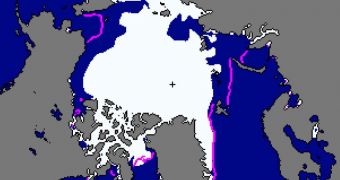Officials at the US National Snow and Ice Data Center (NSIDC) have just released their latest report on the state of ice at and around the North Pole. The newest readings indicate that ices formed at a fast pace throughout October, after reaching the second-lowest extent on record in September.
According to the team that compiled the report, such a sharp increase in ice-covered surfaces is absolutely normal for this year. Still, by the end of October, there were still significant areas in the Beaufort and Chukchi seas that remained ice-free.
Climate experts believe that these areas will freeze over in November, or early December at the latest. However, quantifying the exact effect that climate change and global warming will have on traditional freezing patterns is tremendously difficult.
What is interesting about the aforementioned areas in the Beaufort and Chukchi seas is that they allow waters to remain a bit warmer than usual, which contributes to warm conditions along Siberian coastline, where temperatures reach unusually-high values for this time of year.
Throughout October, the NSIDC reports, Arctic ice cover increased by an “average rate of 114,900 square kilometers (44,360 square miles) per day, about 40 [percent] faster than the average growth rate for October 1979 to 2000,” the report sways.
Researchers say that ice extents reached as much as 8.41 million square kilometers (3.25 million square miles) on October 30, which is the last day for which the team has certain, extensive information.
This represents a slow progress from the level recorded on the same day in 2007 – the year that saw Arctic sea ice levels reach their lowest values in satellite records. The Arctic had only 330,000 square kilometers (127,000 square miles) more ice in 2011 than 4 years ago.
“By the end of October, ice extent remained below the 1979 to 2000 average in the Beaufort and Chukchi seas and in the Barents and Kara seas. Extent was near average in the East Greenland Sea. New ice growth has closed both the Northwest Passage and the Northern Sea Route,” the report says.
“During the month of October, the freeze-up that begins in September kicks into high gear. The rate of freeze-up depends on several factors including the atmospheric conditions and the amount of heat in the ocean that was accumulated during the summer,” the document explains.
“However, each decade, the October extent has started from a lower and lower point, with the record low extent during the 1980s (1984) substantially higher than the record low extent during the 1990s (1999), which in turn is substantially higher than the record low extent during the 2000s (2007),” the NSIDC concludes.

 14 DAY TRIAL //
14 DAY TRIAL //